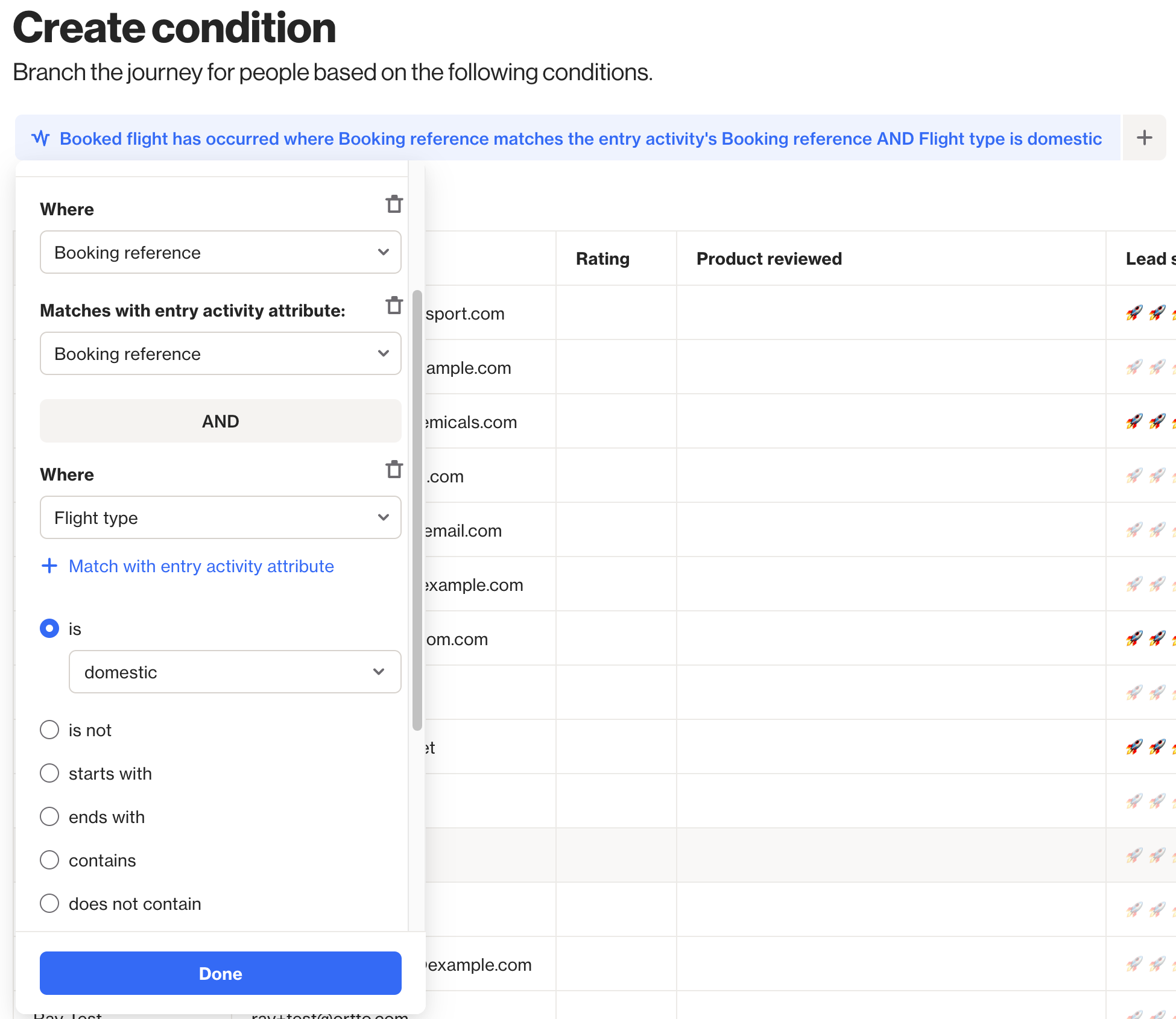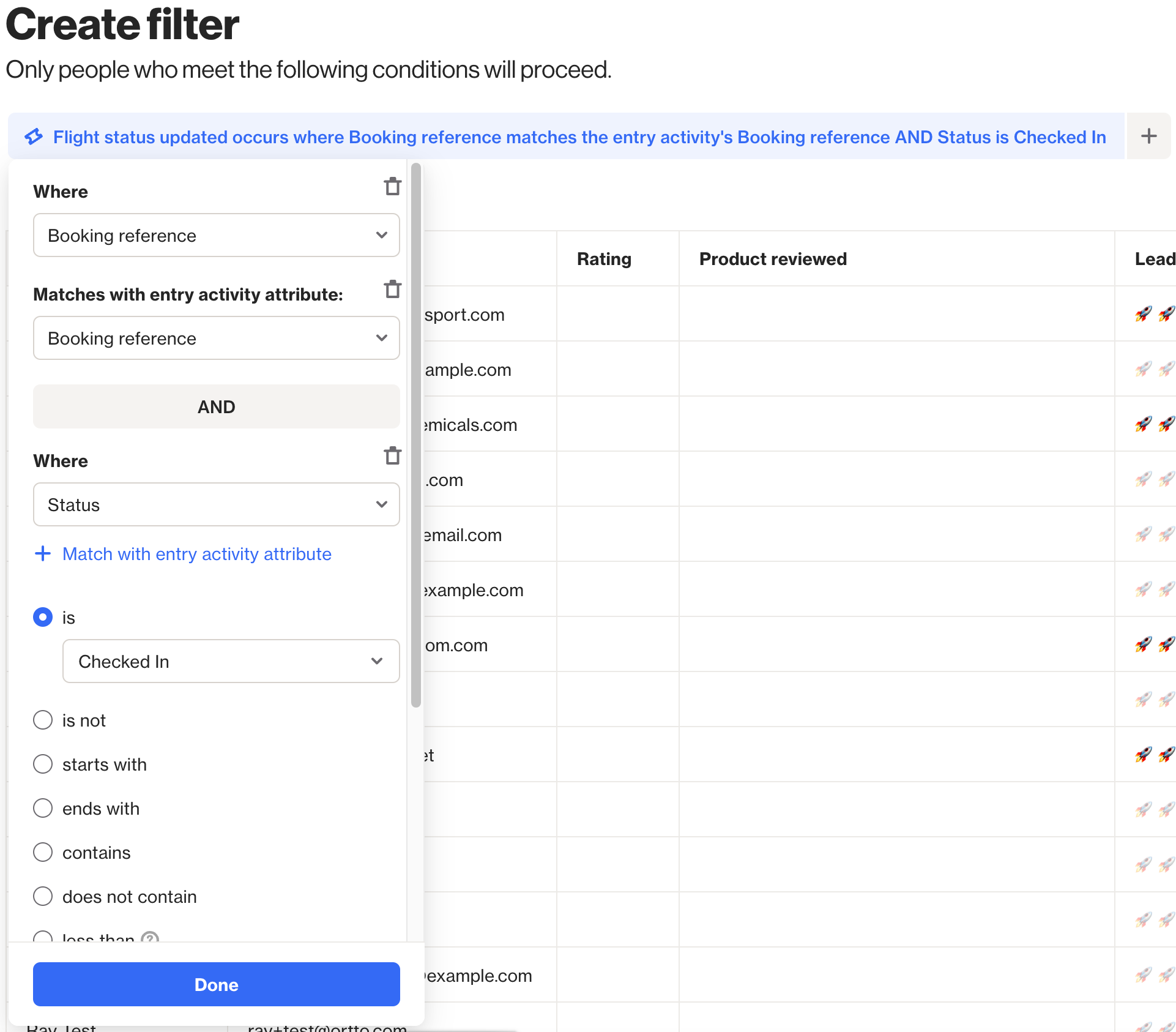Matching activity attributes in journeys
Overview
Ortto's journeys let you match activity attributes to track and manage contacts across related activities.
This guide explains how to match activity attributes in the journey entry and exit criteria, as well as within condition, filter, and delay shapes.
Matching date activity attributes
When matching using a date-type attribute, ensure that the dates being compared align to the same calendar date in the relevant timezone. Matches are only supported if both dates resolve to the same date after timezone conversion.
EX: A date of 2025-07-06 (UTC) converts to 2025-07-06 10:00 AM (Australia/Sydney). Since the calendar date remains 2025-07-06, this is considered a match.
Matching activity attributes in the journey entry criteria
You can set a contact's entry into a journey to trigger when a specific activity occurs, known as a sticky activity.
Sticky activities:
- A sticky activity becomes the primary activity for the journey. This means its attribute values can be used in message content or to update field values.
EX: If the entry criteria is set to Booked flight occurs, you can use merge tags in the journey to display details (like the destination) from the flight booking.
- Only sticky activity attributes can be used to match entry and exit criteria. This is useful for tracking changing states, such as a sales pipeline.
EX: You could use Deal created occurs as the entry and Deal updated occurs as the exit criteria, matching them with a shared attribute like Record ID.
NOTE: When matching using a date-type attribute, ensure that the dates being compared align to the same calendar date in the relevant timezones submitted. Matches are only supported if both dates resolve to the same date after timezone conversion.
For example, a date of 2025-07-06 (UTC) converts to 2025-07-06 10:00 AM (Australia/Sydney). Since the calendar date remains 2025-07-06, this is considered a match.
Non-sticky activities:
On the other hand, if you use x activity has occurred as the entry condition, it won’t be the primary activity throughout the journey.
EX: Using the flight example, if the entry criteria is Booked flight has occurred, any later flight bookings will replace the original flight's details. So, if a contact enters the journey when booking flight A but later books flight B, the merge tag would pull data from flight B, not flight A.
NOTE: Activity data is typically stored in Ortto for 90 days, unless data retention is enabled for the activity. However, the data from the sticky activity that triggers a contact's entry into the journey will be available for the entire duration of the journey. This means that even if data retention is not enabled, the attribute values from the entry activity can be used throughout the journey (e.g., in filters, conditions, and merge tags) for longer than 90 days.
Matching activity attributes in shapes
You can use activity attribute matching in condition, filter, and delay shapes to better manage a contact's flow through the journey.
This feature is designed for journeys where the entry criteria is x activity occurs. In the examples below, we’ll show how to add condition, filter, and delay shapes to a journey triggered when a contact books a flight (e.g., People enter when: Booked flight occurs)
Condition shape
In a condition shape, you can match activity attributes based on the following criteria:
- Has or has not occurred
- First occurred
- Last occurred
- Frequency & time
Condition shapes use x activity occurred criteria for attribute matching, as they capture past events. The activity must already have occurred (or not occurred) before the contact can move through the shape.
EX: You could use a condition shape to check if the booked flight was domestic or international. You would match the Booked flight activity that triggered entry into the journey and review its attributes to get the flight details.
To match activity attributes in a condition shape:
- In the journey flow editor, click the + icon to add a shape and choose Condition > Start from scratch.
- On the Create condition page, click Filter and select the relevant activity (e.g., Booked flight has occurred).
- Add a Where clause and choose the activity attribute to match (e.g., Booked flight has occurred where booking reference).
- Click Match with entry activity attribute and select the entry attribute to match (e.g., booking reference).
TIP: Use a unique value like a booking reference, combined with another attribute (e.g., flight type), to ensure the condition matches the correct activity that triggered the journey entry.
5. Click Done.
6. Click Save to complete the shape setup.

NOTE: If your journey is off or no contacts have entered yet, your condition filter may show 0 potential matches. This is normal, as the condition depends on the journey entry criteria. Until contacts enter the journey (i.e., the entry activity occurs), no matches can be counted.
Filter shape
In a Filter shape, attribute matching is only available for x activity occurs conditions (not for has occurred, first occurred, last occurred, or frequency & time). This is because the filter is designed to hold contacts at the shape until the specified activity occurs. If the activity has already happened before reaching the shape, the contact will wait until it happens again.
EX: Let's say you want to link a Flight status updated activity to the journey's entry activity (Booked flight). Here’s how you can set it up:
- Add a filter shape: In the journey flow editor, click the + icon, select Filter, then choose Start from scratch.
- Set the activity: On the Create filter page, click Filter and select the relevant activity (e.g., Flight status updated occurs).
- Add the attribute match: Under Where, choose the activity attribute to match (e.g., Flight status updated occurs where booking reference).
- Match with entry attribute: Click Match with entry activity attribute, then select the entry attribute to match (e.g., booking reference). We recommend using a unique value, like the booking reference, along with another attribute (like status), to ensure the filter matches the correct activity that triggered the journey.
- Finish setup: Click Done, then Save to complete the setup.

Delay shape
When using a Delay shape, you can match activity attributes to conditions that are different from the journey's entry criteria. This helps link a later activity (like a car hire booking) to the original entry activity (like a flight booking).
EX:
- Add a delay shape: In the journey flow editor, click the + icon, then select Delay.
- Select activity and attribute: In the Add delay modal, choose Activity and select a relevant activity (e.g., Booked car hire) and the corresponding Date attribute (e.g., Return date).
- Match with entry criteria: To ensure the delay is linked to the correct booking, use a unique value (e.g., booking reference) to match the activity attribute (e.g., Booked car hire) with the entry activity (e.g., Booked flight).
- Set offset and date options (if needed): If required, add an Offset and choose how to handle dates that are not set or have already passed.
- Finish setup: Click OK to save the delay shape.

